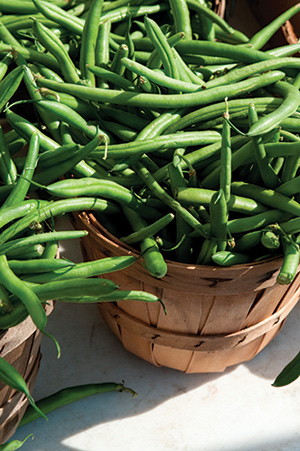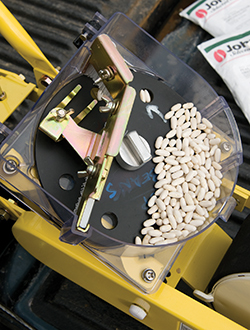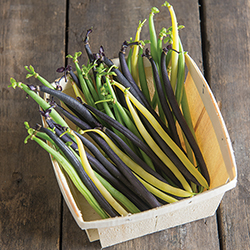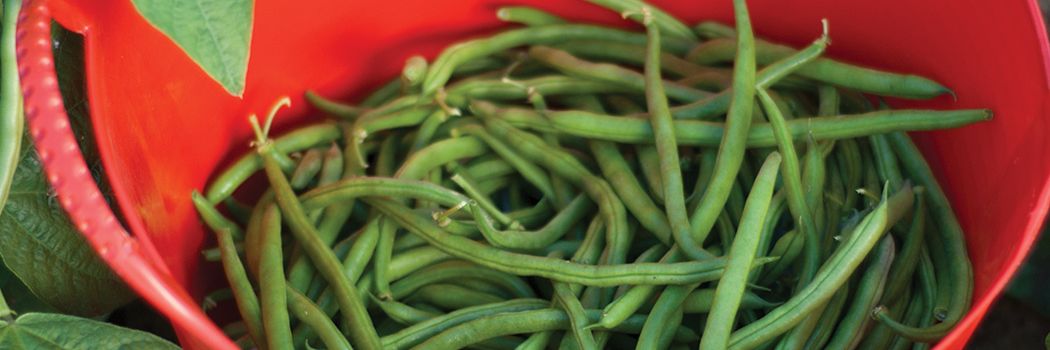- Types of Beans | Bean Basics From Johnny's Selected Seeds
- Video: How to Grow Bush Beans • From Seed to Harvest
- Video: High-Value Crops & Varieties for Your Garden • Tutorial with Niki Jabbour
- Bean FAQs
- Lima Bean | Key Growing Information
- Pole Bean | Key Growing Information
- Bush Beans | Key Growing Information
- French Filet Beans | Key Growing Information
- About Snap, String & Green Beans | Johnny's Selected Seeds
- Fava Bean | Key Growing Information
- Soybean | Key Growing Information
- About Pole Beans | 4 Steps to Success: Select Varieties, Plant Seed & Set Up Your Trellis
- Bush Bean Varieties | Comparison Chart (PDF)
- Fresh Shell Beans | Key Growing Information
- How to Grow Pole Beans • From Seed to Harvest
What Is Johnny's Snap Bean Advantage?
Snap beans are widely grown and go by many different colloquial names — bush beans, string beans, and green beans, to name just three of their favored aliases. But when choosing the beans we'd rather grow and bring to the table, there's just one thing we put above all else: FLAVOR. We grow beans to feed ourselves and others, so when selecting our bean varieties, it all boils down to the eating experience for us.
Flavor Over Fiber: The Case for the Crooked Bean

View All Our Bush Beans…
Two primary characteristics govern the eating quality of beans: flavor and fiber. The more flavor the better, and the less fiber the better.
Beans for processing get cut up during the canning or freezing process, so the straightness of processing beans is not critical, and a breeder of processing beans can focus on selecting for better flavor and lower fiber.
Bean Beauty Tip: Drink Plenty of Water
Water stress is a cultural factor that can strongly influence bean pod shape and quality. To grow beautiful beans, it's important to ensure regular watering or irrigation during the flowering, pod set, and pod growth stages, to keep water stress to a minimum.
Fresh market beans, in contrast — the ones you see in the produce section of the supermarket — are conventionally bred for straightness, to make them prettier as well as easier to pack and ship and stack and store. Straightness in fresh market beans requires their tissues to contain a much higher percentage of fiber than processing beans, and hence they are not nearly as tender to the tooth as processing types.
Because we select first and foremost for flavor, Johnny's beans may not be quite as straight as your typical supermarket bean — but they are much more enjoyable!
Other Important Traits in Snap Beans

Here are some additional criteria that are important for us when selecting our snap beans (as well as other types of beans).
- Seed color. In cool, moist soils, dark-seeded beans germinate better than white-seeded beans. The reason most modern commercial beans are white-seeded is because they look better when processed. The seeds of dark-seeded varieties become grayish when processed.
- Upright plant habit. We look for a sturdy, upright growth habit in the beans we trial. A plant that stands up well will minimize pod-to-soil contact, which results in less disease and fewer rotten bean pods. An upright plant is easier to weed and to pick.
- Yield. Pick, Pick, Pick! The key to maximizing yield is to keep the plant picked so it continues to produce. For a crop like beans, this means every 5–7 days for regular bush beans, and every other day for filet beans.
Snap Bean Varieties to Consider Growing
 Organic 'Trilogy'
A mix designed to provide a season-long harvest of beautiful, delicious organic snap beans.
Organic 'Trilogy'
A mix designed to provide a season-long harvest of beautiful, delicious organic snap beans.
Johnny's line of beans includes a delicious selection of snap varieties. Here are some recommendations for season-long snap bean success.
- Start your season with the dark-seeded 'Provider,' which germinates well in cooler soils. Then move into the tried and true 'Jade' — dependably dark green and prolific.
- Keeping up with bean picking can be tiresome — but a variety like 'Affirmed' can make life easier. The plants' upright habit and concentrated set is amenable to both machine and hand harvest.
- Chefs and gourmands will appreciate 'Tavera.' Its extra-fine pods are suitable for serving "whole on the plate."
- Brighten up the display or plate with some vivid purple and yellow beans, like 'Amethyst' and 'Rocdor.' Note that purple beans become green when cooked, whereas yellow beans (aka wax beans) stay yellow.
- For 3 colors from one bean planting, be sure to check out 'Trilogy' — particularly nice for those with smaller plots, backyard gardens, and urban growing.
- To compare the bushy, mounding types of snap beans, see our Bush Bean Comparison Chart.
Snap Beans vs. Green Beans

Johnny's line of beans includes a delicious selection of snap varieties. Here are some recommendations for season-long snap bean success.
- Start your season with the dark-seeded 'Provider,' which germinates well in cooler soils. Then move into the tried and true 'Jade' — dependably dark green and prolific.
- Keeping up with bean picking can be tiresome — but a variety like 'Affirmed' can make life easier. The plants' upright habit and concentrated set is amenable to both machine and hand harvest.
- Chefs and gourmands will appreciate 'Tavera.' Its extra-fine pods are suitable for serving "whole on the plate."
- Brighten up the display or plate with some vivid purple and yellow beans, like 'Amethyst' and 'Rocdor.' Note that purple beans become green when cooked, whereas yellow beans (aka wax beans) stay yellow.
- For 3 colors from one bean planting, be sure to check out 'Trilogy' — particularly nice for those with smaller plots, backyard gardens, and urban growing.
- To compare the bushy, mounding types of snap beans, see our Bush Bean Comparison Chart.
Snap beans and green beans are one and the same: bean varieties that are eaten fresh, pod and all, while the beans are still immature and the pod has a satisfying crunch or “snap” to it. String beans are another name commonly applied to this type of bean; however, many varieties have been bred to have little or no string. Finally, some may refer to snap beans as bush beans, however, there are snap bean varieties in both classes of plant habit (pole and bush).


